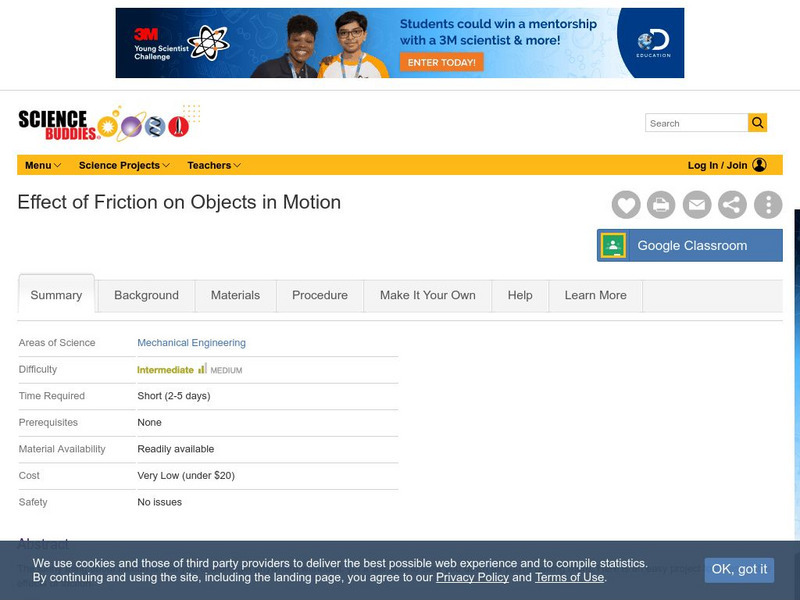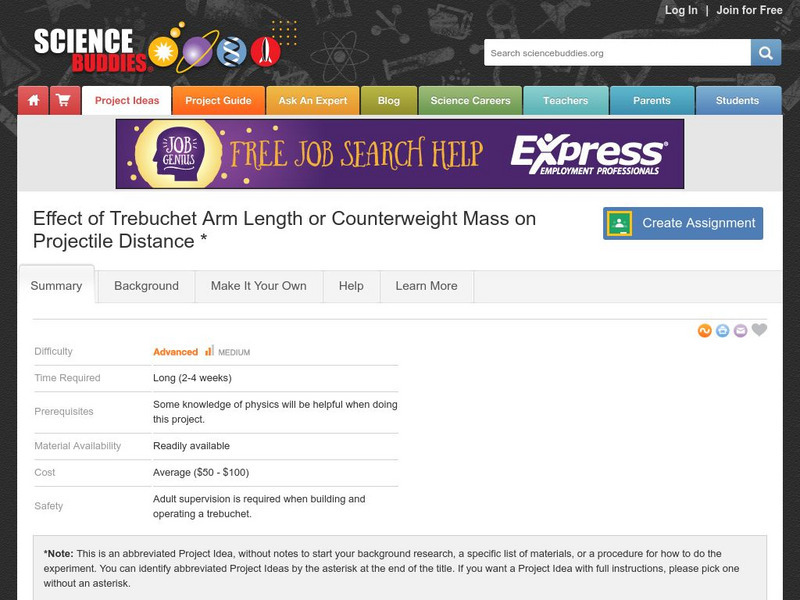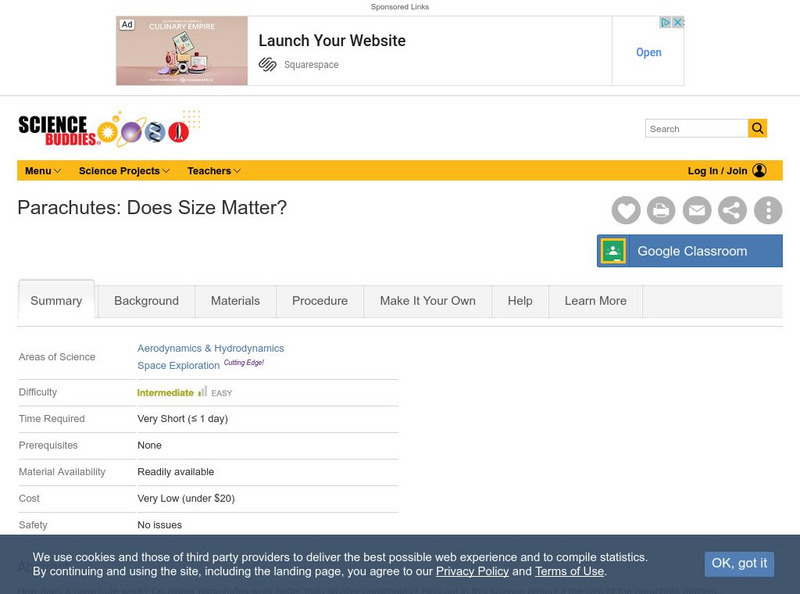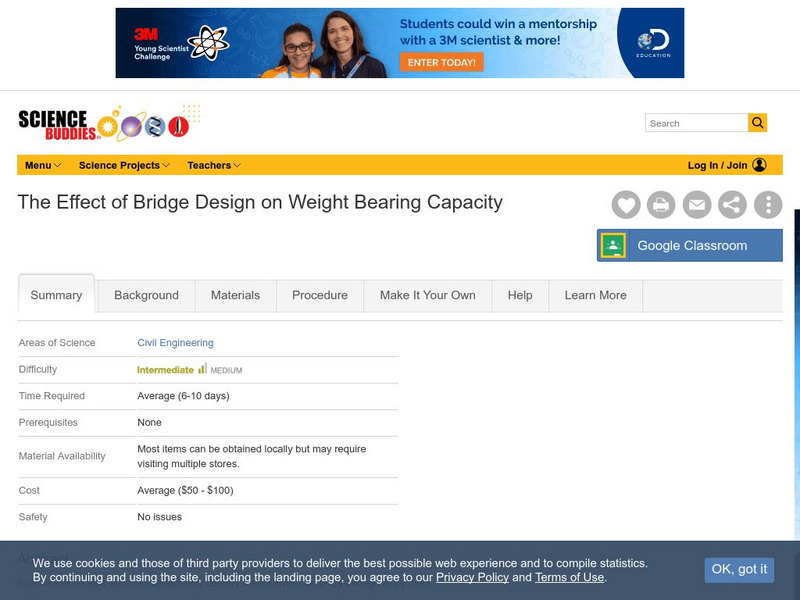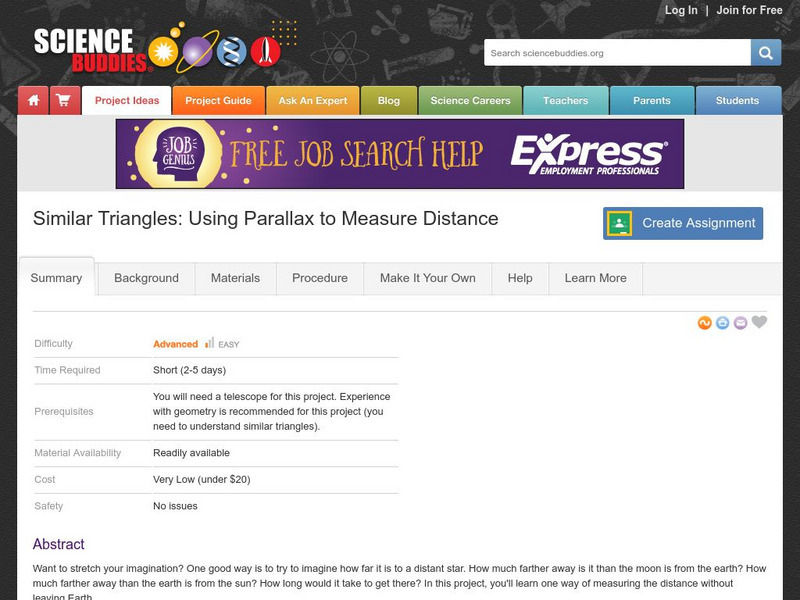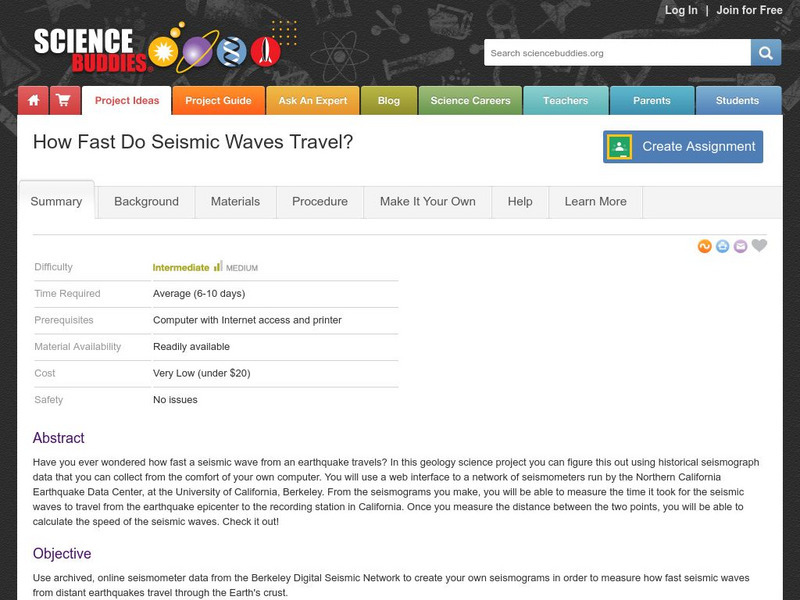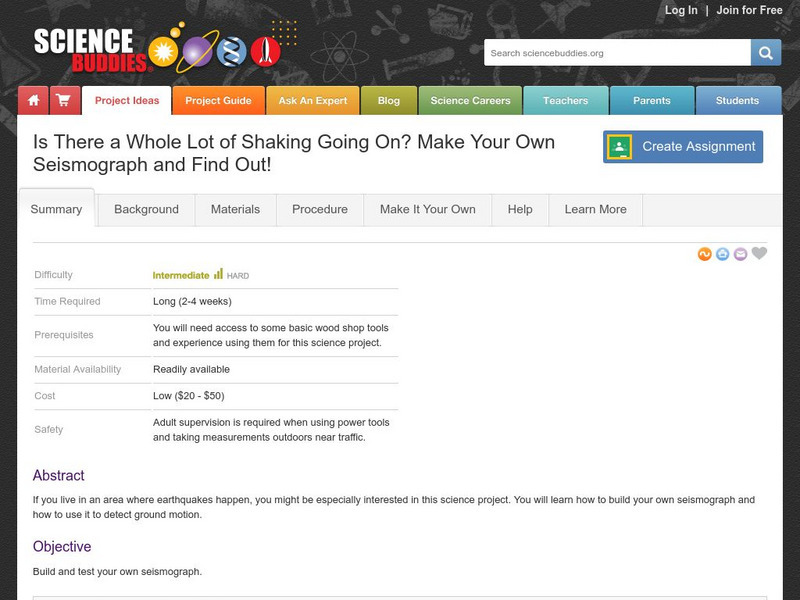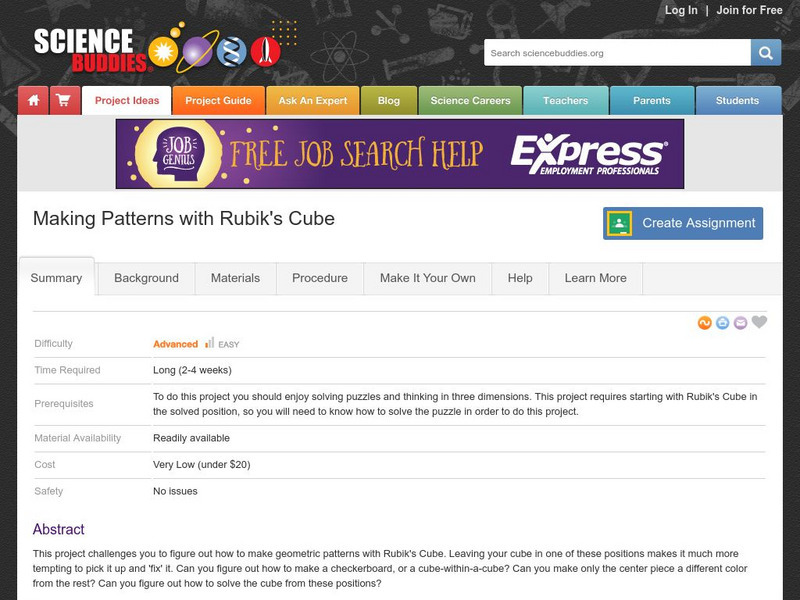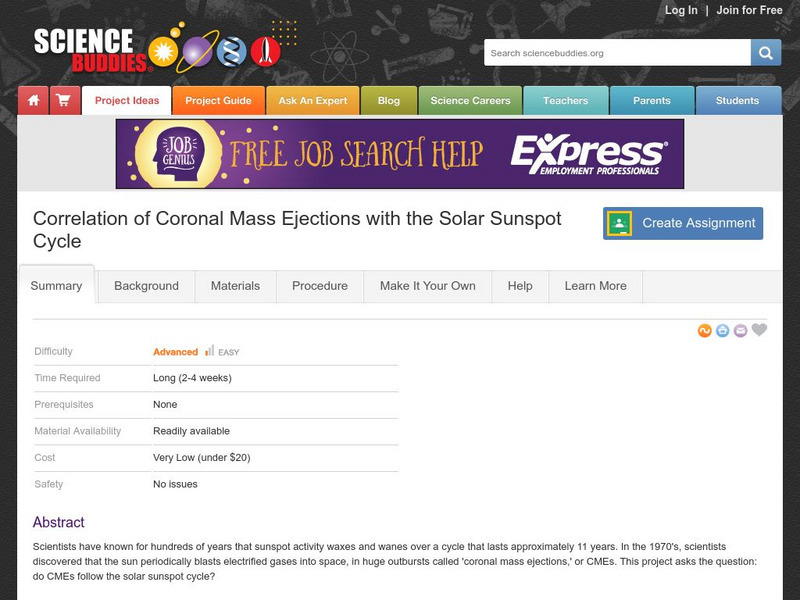Science Buddies
Science Buddies: The Viscosity of Motor Oil
The insides of a car engine get very hot when the engine is running. Motor oil lubricates the moving parts, to keep the engine operating smoothly. Learn what happens to motor oil as the engine temperature goes up.
Science Buddies
Science Buddies: Effect of Friction on Objects in Motion
The funny thing about friction is that you couldn't get anywhere without it, yet it still acts to slow you down as you're getting there. Here is an easy project to measure the effects of friction.
Science Buddies
Science Buddies: Effect of Trebuchet Arm Length or Counterweight Mass on Project
A trebuchet is a catapult that uses a counterweight to supply the energy for throwing. They were used in the Middle Ages for attacking castle walls. In this project, you build your own model trebuchet and investigate how design changes...
Science Buddies
Science Buddies: Fractography: The Way Things Break
When something goes wrong, do you like to try to figure out why? Engineers do this all the time. They even have a fancy name for it: failure analysis. Understanding how different materials break is an important part of failure analysis....
Science Buddies
Science Buddies: How Many Numbers Can You Remember?
Most people don't even remember phone numbers anymore, and instead program them into their phones. There is a limit to the number of numbers, or digits, that most people can remember. Try this experiment to test your digit span, the...
Science Buddies
Science Buddies: Let's Go Fly a Kite!
By making a simple sled kite from the template provided and using the suggestions in the Science Buddies project, you can experiment with variables that test different aspects of flight. The Science Buddies project ideas are set up...
Science Buddies
Science Buddies: Parachutes: Does Size Matter?
Experiment with different sizes of parachutes to find out if size matters when slowing the descent of the parachute. The Science Buddies project ideas are set up consistently beginning with an abstract, objective, and introduction,...
Science Buddies
Science Buddies: How Does Ratio of Sand to Cement Affect Strength of Concrete?
Concrete is one of those things that most of us don't think about much, yet we use it every day. We walk on concrete sidewalks, drive on concrete roads, and live and work in buildings with foundations made of concrete. It is a durable...
Science Buddies
Science Buddies: Efficient Propeller Design
There's a lot to understand about the simple propeller to see how it affects lift and thrust in an airplane or helicopter. This Science Buddies project gives you lots of ideas on how to change the design of the propeller to achieve...
Science Buddies
Science Buddies: Underground Water Flow and Darcy's Law
This project shows you how to build a simple model system to simulate underground water flow. Underground water flow is important for understanding replenishment of underground aquifers, migration of underground contaminant plumes, and...
Science Buddies
Science Buddies: The Effect of Bridge Design on Weight Bearing Capacity
This Science Buddies project asks that you identify different kinds of bridges, discover why they are built as they are, and then build three different bridges of your own out of balsa wood. See which one you think can bear the heaviest...
Science Buddies
Science Buddies: Tracking Geomagnetic Storms in the Ionosphere
The Sun is the ultimate source of the energy that powers weather systems on Earth. Geomagnetic storms are sun-powered storms in the upper atmosphere, arising from energized particles that are periodically ejected by the Sun. Among other...
Science Buddies
Science Buddies: Similar Triangles: Using Parallax to Measure Distance
Want to stretch your imagination? One good way is to try to imagine how far it is to a distant star. How much farther away is it than the moon is from the earth? In this project, you'll learn one way of measuring the distance without...
Science Buddies
Science Buddies: Measuring Vibrational Frequency With Light
Strike a key on the piano, and you hear the string vibrating. Just about any object vibrates when it's knocked, but how much and how fast? This project helps you find out. You'll build a simple light-sensing circuit for measuring the...
Science Buddies
Science Buddies: Focusing Your Flash for 'Freezing' Motion
Here's an interesting flash photography project. With an inexpensive Fresnel lens, you can concentrate the light from your flash. You'll be able to shoot with a smaller aperture and a shorter flash duration. This will give you a greater...
Science Buddies
Science Buddies: Get Some Practice at 'Fossil' Reconstruction With Owl Pellets
Although this project is not based on actual fossils, you will get good practice at reconstructing an animal's skeleton from individual bones. The goal of this science project is to identify the types of prey that are consumed by owls by...
Science Buddies
Science Buddies: The Chemistry of Hair Highlights
Have you ever tried to make parts of your hair lighter than the rest of your hair? Perhaps the way you tried to do it did not lighten it or maybe it turned out a shade of orange. With this science project you can understand why.
Science Buddies
Science Buddies: How Fast Do Seismic Waves Travel?
Here's a geology project that uses historical seismograph data that you can collect from the comfort of your own computer. You'll use a web interface to a network of seismometers run by the Northern California Earthquake Data Center, at...
Science Buddies
Science Buddies: What's All That Shaking? Make Your Own Seismograph!
If you live in an area where earthquakes happen, you might be especially interested in this science project. You'll learn how to build your own seismograph and how to use it to detect ground motion.
Science Buddies
Science Buddies: Making Patterns With Rubik's Cube
This project challenges you to figure out how to make geometric patterns with Rubik's Cube. Leaving your cube in one of these positions makes it much more tempting to pick it up and 'fix' it. See if you can determine how different...
Science Buddies
Science Buddies: Devising an Algorithm for Solving Rubik's Cube
If you're the kind of person who has taken apart your Rubik's cube in order to grease the inside parts so it will move more smoothly, this could be a great project for you. This will show you three sets of move sequences that accomplish...
Science Buddies
Science Buddies: Observatory Satellite Measures Motion of Coronal Mass Ejection
The sun sometimes releases huge bursts of electrified gases into space. These bursts are called coronal mass ejections (or CMEs). When CMEs are directed towards Earth they can generate auroras, the spectacular atmospheric displays also...
Science Buddies
Science Buddies: Correlation of Coronal Mass Ejections With Solar Sunspot Cycle
Scientists have known for hundreds of years that sunspot activity waxes and wanes over a cycle that lasts approximately 11 years. In the 1970's, scientists discovered that the sun periodically blasts electrified gases into space, in huge...
Science Buddies
Science Buddies: Buoyancy of Floating Cylinders
This project presents an interesting puzzle. A disk of wood will float face-up, that is, with its circular cross-section parallel to the surface of the water. A long log of wood, however, floats with the circular cross-section...



